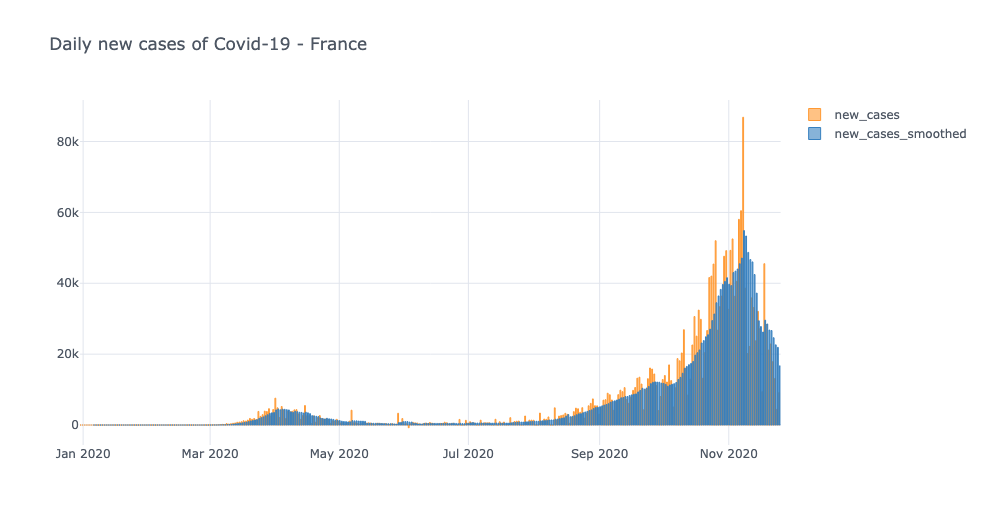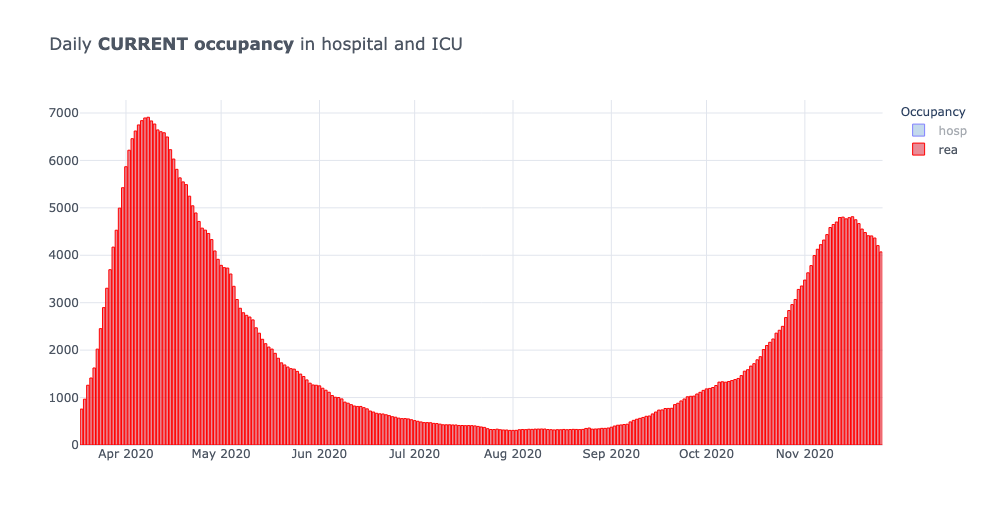Nov 25 Update, v2
It’s November 25 2020, and we’re now almost 1 month into our second-wave confinement that started on Oct 28.
The good news: it’s working.
Errata Nov 26: There was a calculation error in the original article, in last section discussing feasibility of new targets. The upshot is the ICU target is actually more feasible than in the original version.
.
Recap of improvements since Oct 28 2020
-
At the national level, all Covid metrics are decreasing, from incidence rates (positive tests per 100k population) to new deaths per day.
-
Incidence rates peaked a few days after confinement, and have fallen to well below pre-confinement levels. Nonetheless, they are still very high.
-
ICU occupancy by Covid patients has begun to decrease. From a peak of ~95% on Nov 16 it’s now down to ~88% as of Nov 24. However this is still much higher than it was on Oct 28 (~59%).
What does this mean for those living in France?
Ultimately, what it means is that Covid infections have slowed enough for the government to begin easing restrictions.
As of this Saturday (Nov 28):
-
shops and small business like hairdressers will be allowed to re-open, with restrictions.
-
places of worship can welcome worshippers, with restrictions.
-
individuals still have to complete attestions before leaving home, but we’ll be able to wander further: up to a 20km radius, and for up to 3 hours duration.
What will happen for the holidays?
Interestingly, further easing of restrictions is explicitly tied to improvements in the case numbers and ICU. In other words, the ball is in our court.
If, by Dec 15, we can remain vigilant enough for:
- new daily cases to go down to 5000, AND
- ICU Covid occupancy descend to between 2500 to 3000 beds
confinement will be lifted for individual travel in France, and more businesses will be allowed to-reopen and activities to resume.
This summary explains what gets “unlocked” IF we reach these levels by Dec 15, courtesy Le Parisien.

How achievable are these targets?
Assuming current trends hold steady:
- Daily new cases < 5000: seems very feasible
The last time we were as low as 5000 daily new cases was at the end of August, which might seem dauntingly far away.
However, new cases are dropping much faster than they were growing before confinement: since confinement started, we’ve already gone down from a peak of 60,000 cases to fewer than 10,000.

So returning to 5000 cases/day within the next 3.5 weeks seems very do-able.
On the other hand..
- ICU occupancy between 2500 & 3000 beds: seems possibly feasible
The last time we had fewer than 3000 ICU occupied by Covid patients was Oct 28.

Going from a peak of 4813 on Nov 16 to 3000 bed occupancy represents a 38% decrease.
So far, ICU occupancy has gone from a peak of 4813 to 4071 (-742), a 15% decrease from peak. This has taken 9 days. Divide 15% by 9 days = 1.67% decrease per day.
29 days multiplied by -1.67% = -48.43% decrease from peak, which is 2330 beds. So if ICUs keep emptying at the same pace, we might even overshoot the target.
So why only “possibly” feasible?
As you can see in the plot above, we saw a steady decrease in ICU occupancy from the peak during the first wave.
However the difference back then was that there were only a few Covid hotspots - IDF, Grand Est, and to a lesser extent Hauts de France.
Now, all of France is impacted and more people are moving about. When you compare ICU occupancy for the regions, the decreases now look a lot less steady.
In fact, some regions are still plateau-ing, while Grand Est is still increasing.
All in all, it makes me wonder if at the national level, we will see a bumpier decrease in ICU occupancy this time round.
Coming soon
Over the next few days I’ll be updating the Covid Dataviz website to more clearly show if we’re on target for meeting those numbers.
In the meantime, you can still see in more detail how incidence rates & ICU stress have been evolving here.